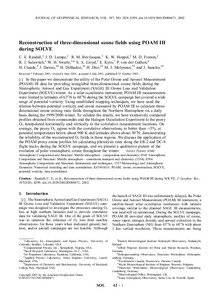Por favor, use este identificador para citar o enlazar este ítem:
http://hdl.handle.net/20.500.11765/2297
Reconstruction of three-dimensional ozone fields using POAM III during SOLVE
| Título : | Reconstruction of three-dimensional ozone fields using POAM III during SOLVE |
| Autor : | Randall, Cora Einterz; Lumpe, J. D.; Bevilacqua, Richard M.; Hoppel, Karl W.; Fromm, M. D.; Salawitch, Ross J.; Swartz, William H.; Lloyd, S. A.; Kyrö, Esko; Gathen, Peter von der; Claude, H.; Davies, Jonathan; Backer, Hugo de; Dier, Horst; Molyneux, M. J.; Sancho Ávila, Juan Manuel


|
| Palabras clave : | Polar ozone; Aerosol measurement; Stratospheric ozone |
| Fecha de publicación : | 2002 |
| Editor: | American Geophysical Union |
| Citación : | Journal of Geophysical Research: Atmospheres. 2001, 107(D20), p. SOL 42-1–SOL 42-13 |
| Versión del editor: | https://dx.doi.org/10.1029/2001JD000471 |
| Resumen : | In this paper we demonstrate the utility of the Polar Ozone and Aerosol Measurement (POAM) III data for providing semiglobal three-dimensional ozone fields during the Stratospheric Aerosol and Gas Experiment (SAGE) III Ozone Loss and Validation Experiment (SOLVE) winter. As a solar occultation instrument, POAM III measurements were limited to latitudes of 63°N to 68°N during the SOLVE campaign but covered a wide range of potential vorticity. Using established mapping techniques, we have used the relation between potential vorticity and ozone measured by POAM III to calculate three-dimensional ozone mixing ratio fields throughout the Northern Hemisphere on a daily basis during the 1999/2000 winter. To validate the results, we have extensively compared profiles obtained from ozonesondes and the Halogen Occultation Experiment to the proxy O3 interpolated horizontally and vertically to the correlative measurement locations. On average, the proxy O3 agrees with the correlative observations to better than ∼5%, at potential temperatures below about 900 K and latitudes above about 30°N, demonstrating the reliability of the reconstructed O3 fields in these regions. We discuss the application of the POAM proxy ozone profiles for calculating photolysis rates along the ER-2 and DC-8 flight tracks during the SOLVE campaign, and we present a qualitative picture of the evolution of polar stratospheric ozone throughout the winter. |
| URI : | http://hdl.handle.net/20.500.11765/2297 |
| ISSN : | 2169-897X 2169-8996 |
| Colecciones: | Artículos científicos 2000-2004 |
Ficheros en este ítem:
| Fichero | Descripción | Tamaño | Formato | ||
|---|---|---|---|---|---|
| Randall_2002-JGR.pdf | 1,87 MB | Adobe PDF |  Visualizar/Abrir |
Los ítems de Arcimis están protegidos por una Licencia Creative Commons, salvo que se indique lo contrario.





